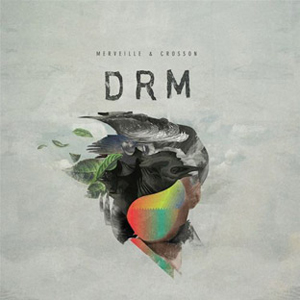Merveille & Crosson DRM
If the members of Visionquest were looked at like a popular rock band—with Seth Troxler […]

If the members of Visionquest were looked at like a popular rock band—with Seth Troxler playing the part of the adored frontman and party boy Lee Curtiss as the wild drummer—Ryan Crosson might be the lead guitarist, the focused musical intellect who is forever collaborating, expanding his sound to the adoration of critics, and avoiding mainstream fame out of integrity for his art. Of course, each member of Visionquest is a musical mind in his own right, deserving equal credit for the playful, underground house and techno that the quartet is serving up both as producers and label owners, but with the imprint’s debut long player, DRM, Crosson and his studio partner, Cadenza‘s Cesar Merveille, have raised the bar—and the brow—of Visionquest’s offerings.
Consistently repping the far left of the Visionquest sound, Crosson fits right in with Luciano and the Cadenza aesthetic, so it’s no surprise that he and Merveille would gel so naturally. And DRM is nothing if not organic. This is a collection of tracks where each feels more like a fluid evolution than a calculated construction, likely the result of marathon freeform recording sessions where eight- to 10-minute segments were polished up for inclusion. Take the jazz riffing on an excursion like “Again & Again,” a track which echoes with the distorted ghosts of big bands past as brass bursts and a lone hi-hat give way to thick funk bass and a clunking drum kick. Playing like a ’70s-era Miles Davis, No Regular Play wunderkind and Matthew Dear bandmate Greg Paulus lends his psychedelic trumpet to the mix, the result sounding like Davis’ Water Babies tapes had Carl Craig been in on the action.
The album’s title track and lead single keeps this jazz-funk-house feel rolling. Puddle-splash beats and subterranean bass quakes recall Art Department and the symphonic screeches and cymbal crashes are all Crosson, but the solo marimba that defines “DRM” seems to come straight from the mind (and hands) of Merveille, whose past work has always displayed a passion for jazz. While it lends the track a heavy lounge vibe, when coming from these two, it’s more in line with kind of meandering deep techno favored by Innervisions associates Âme or Henrik Schwarz. This is also true of the sparkling “Orca,” the more orchestral track from DRM‘s advance EP. On it, the vibraphone is paired with layers of glowing xylophone, taut snare taps, grandiose timpani, and the muted French-horn blasts that give the work its name. As the final refrain strips everything save the rhythm and a bebop scat of a vocal, it’s easy to see why this was one of the tracks chosen to build anticipation for the album; “Orca” is probably the closest Crosson and Merveille actually get to the dancefloor.
As a welcome juxtaposition, the off-kilter techno of “Escale,” the appropriately titled “Pending,” which features expert piano work from a classically trained Kate Simko and Arthur Simonini, and the flowing ambiance of “At the Seams,” which also features Simonini, present something far more nebulous, as they’re exercises in sound and style rather than traditionally arranged songs. “Pending” tiptoes along with the delicate plucking of strings, its moving melody gliding across the gurgle of minimal electronics. It leaves you waiting for a drop that never comes, and that’s the point. There’s time for that later on in the record. With DRM, Crosson and Merveille sat down with an album in mind, one that doesn’t read like a compilation of singles. Moving from lush, abstract electronica to avant-garde dance that recalls Arthur Russell to forward-thinking tech-house that’s all their own, the two producers have moved well beyond merely appeasing the dancefloor to present a level of sophistication that, as the first full-length release for Visionquest, makes them a tough act to follow.

